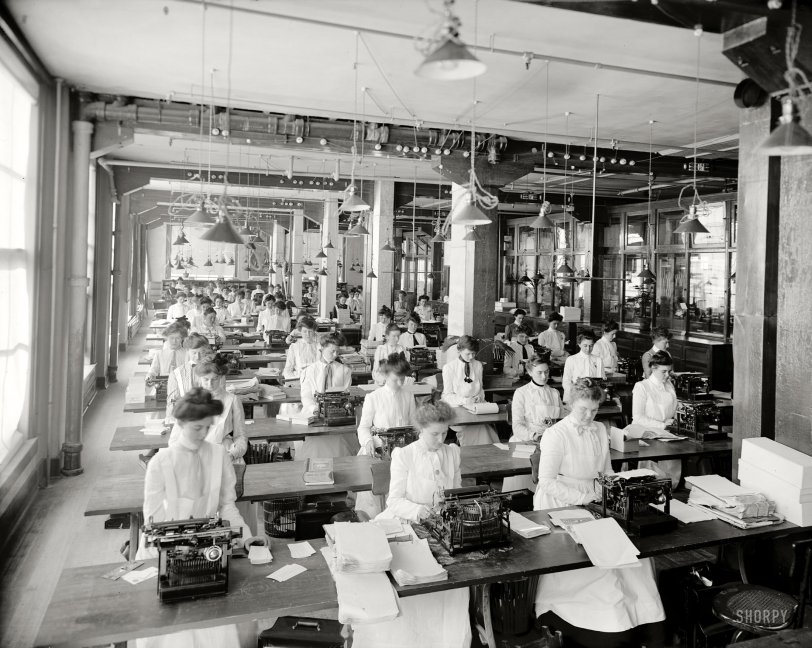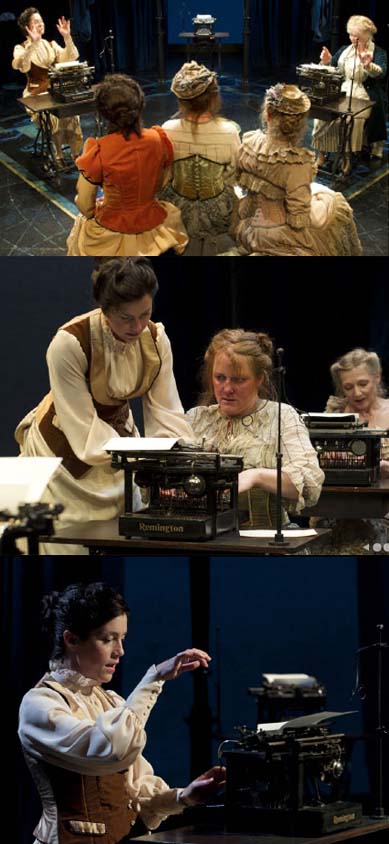


Framed or unframed, desk size to sofa size, printed by us in Arizona and Alabama since 2007. Explore now.
Shorpy is funded by you. Patreon contributors get an ad-free experience.
Learn more.

- Details, Details
- What's that building to the left of the tower?
- Coal Barges
- Bromo-Seltzer
- Inner harbor
- The Basin
- What a headache!
- Giant stepladder?
- Baldwin 62303
- Baldwin VO-1000
- Cold
- No expense spared
- Tough Guys
- Lost in Toyland
- And without gloves
- If I were a blindfolded time traveler
- Smoke Consumer Also Cooks
- Oh that stove!
- Possibly still there?
- What?!?
- $100 Reward
- Freeze Frame
- Texas Flyer wanted
- Just a Year Too Soon
- WWII -- Replacing men with women at the railroad crossing.
- Yes, Icing
- You kids drive me nuts!
- NOT An Easy Job
- I wonder
- Just add window boxes
Print Emporium
Qwerty Women: 1902

Dayton, Ohio, circa 1902. "Typewriting department, National Cash Register." 8x10 inch glass negative by William Henry Jackson. View full size.
The National Cash Register Plan
National Cash Register has some of the very best factory-people-lifestyle photos on the internet. You will see women in the "women's" lunch room, women in workrooms, men in workrooms attending the different stages of making the cash register all looking crisp and tidy as in the above photo. NCR also provided row house neighborhoods on NCR property for its employees probably as well as doctors and grocery stores, tying all aspects of the employee, to the company. I imagine NCR ran a tight ship with a tight employee code. The Ford company also provided this for their employees. An interesting if not unnerving concept today.
Age of Arousal
Earlier in our theatre season, I had to come up with three Remington Invisibles, and desks, this for a production of "Age of Arousal." Here is our take on a similar situation.

Caligraph
The woman front and center is using a Caligraph: no shift key, separate keys for lowercase and uppercase letters (in different arrangements). No touch typing there!
Typereaders
Looking carefully, I can see several women without a typewriter in front of them. I suspect there's woman in each row without a typewriter is actually a proofreader, making sure that there are no egregious errors in the pages typed by her row-mates.
And sexist it might be, but I wonder if the men at the back are possibly fixing that particular typewriter.
I notice also that a lot of the women are typing what appear to be index or catalogue cards, possibly part of the accounting system?
Another fascinating photograph.
Dress code
According to a family friend that worked in a similar circumstance - you had to wear a white blouse to the neck and long sleeves. Your skirt had to come to the ankle, and your hair had to be kept up and tidy appropriate to office standards. Her job did not require an apron, but if you had to have one, it was to be spotless. Her cousin kept an extra on hand, in case she needed to change her apron.
No. 2
The majority of these look to be Remington No. 2s or equivalent. They were "invisible" typewriters -- the keys struck the bottom of the platen and you couldn't see what you were typing without raising the whole roller. The woman in the front row middle has hers raised.
Ringer in back
Unless I'm mistaken, there's a guy typing all the way at the back, between the columns in the center of the picture. Looks like another guy lurking over his shoulder. Was this a job he hid from his buddies? Or did he brag of spending his days surrounded by pulchritude? As for the hairstyle, it's the Gibson girl look, very fashionable at the turn of the 20th century.
The white tops
Probably were company policy as company dress codes were big until about 1970. My mom worked in the Infants & Children's clothing department of JC Penney and even they were supposed to wear white uniforms with white stockings and shoes in the 1950s, as did medical personnel.
A few men
There are a few men in there in the back right corner. I wonder if this was an acceptable job for men in those days? I don't know for sure, but I believe most of them wore the white aprons to protect their clothing from ink stains. Anyone who has ever used an old typewriter knows they are notorious for leaving one's fingers and clothing stained if not careful.
Easy Virtue
I bet the shameless woman wearing the colored suit on the far right was known to her female co-workers as a woman of "easy virtue" and a gal that was always ready to show a fellow a "good time!"
Noise
Not only the noise of the keys, but imagine the ringing of the bells before each carriage return (if they had all the bells and whistles c. 1902).
Whew.
Whenever I see pictures like this, I'm so glad I'm a woman born well into the second half of the 20th century.
Hair Caught
There's no danger of any of them getting their long hair caught in their typewriter. Maybe the hair styles aren't really a fashion statement.
Electric Light, Steam Heat.
By today's standards the electric distribution for the hanging shaded electric lamps would be deemed unsafe.
On the large crossbeam above the second-from-the-right hanging lamp are porcelain fuse holders with screw-in fuses.
The electric service wires then travel to the left horizontally along the beam towards the windows, the wires held in vertical porcelain blocks which hold the wires well separated.
Between the upper and lower horizontal feed wires, round junction taps are installed to supply electric power to each hanging lamp suspended on braided wire.
The lamp shades are glass with the colour green cast in the glass in the upper surface, white below to reflect light downwards.
Until their demise, almost every small railway station had a similar green-shaded lamp hanging over the desk in the bay window facing the track.
Below the fourth and fifth windows on the left are serpentine pipe coils which would radiate heat when steam was passed thru them.
These pipes would always clank and bang from expansion when warming up, a welcome sound on cold days.
Thank You.
The new girl.
Third row, third from left doesn't appear to have a typewriter yet. In the absence of Solitaire, she might have been playing Tic Tac Toe.
Summer?
Is that a palm tree in the background? Could summer account for the lightness of their clothes? You can imagine a room like that could get fairly warm.
Dressed alike? Not too sure.
While I do look at this picture and think that they're all dressed pretty much alike, I bet they'd think you were crazy if you told them that. First of all, I bet color would change the perception a lot. Second, I think our eyes aren't as trained to the details of that style of clothing. On one level, sure, they're all very similar: high collars, kerchiefs, long sleeves, etc. But the details are as different as a group of office workers' clothes today. And I bet that if one of them looked at an office picture of today they'd say that all the clothes look the same too.
Some of the women seem to be wearing the same smock (or whatever it's called) but that's a separate issue. Including that in the "isn't it weird that they're all dressed so similarly" concept would be like thinking it's odd that all the people in a McDonalds are dressed similarly.
Gibson Girls
They are wearing their hair in the style made popular by the famous portraitist of the time Charles Dana Gibson, especially the young lady on the left front. I'm certain the dress code, along with everything else at that time, was very strict, too. And I'll bet that not one of them was late to work.
No Mistakes
If they made a typing mistake did they have to start the document over?
I don't see any correction fluid bottles.
Maybe they just passed one around.
Nary a bottle of white-out anywhere
I wonder how fast most of the could type -- probably 70-80 wpm -- and how often they made mistakes.
Some years ago I was looking at the file copies of my university department's PhD dissertations. The ones from the 40s and 50s were bound carbon copies and would go on for page after page after page without a correction: the standard of typing was just that high. And I suspect that they were typed at 70-80 wpm.
This comes from someone who can barely type their name on a word processor with making two or three errors. Thank heavens for spell-check.
Oh Dear,
I'm sorry ladies, I was looking for the Faulty Wiring Department and naturally stepped in here.
Hair and there
Does NCR have a hair do code? All the women have the same hair style.
Clackety-clack
Looks like maybe 75 typists - 15 rows of 5, give or take. Must have been noisy when they really got cranked up.
I was rummaging through my attic a few years ago with my 15-year old niece, and showed her my 45-year old manual Corona typewriter that I used to type my senior thesis (along with a couple of gallons of "white-out".) She was absolutely mesmerized. Almost as fascinating as her grandmother's rotary telephone, still hanging on the wall of her kitchen even today.
Earplugs not included?
I wonder how unbearable the sound in that room could become.
Uniform Hairstyle
Do you think it was company policy or fashion of the day?
All in white
With few exceptions they are all dressed more or less alike. Fashion, company policy or company culture?
























On Shorpy:
Today’s Top 5